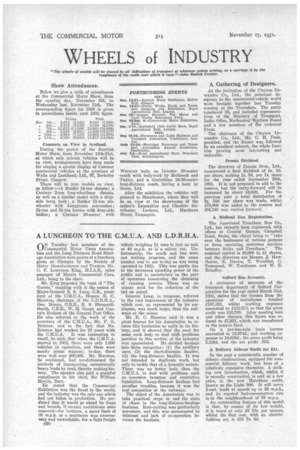A LUNCHEON TO THE C.M.U.A. AND L.D.R.H.A.
Page 42

If you've noticed an error in this article please click here to report it so we can fix it.
ON Tuesday last members of the Commercial Motor Users Association and the Long Distance Road Haulage Association were guests at a luncheon given at Olympia by the Society of Motor Manufacturers and Traders, Mr.
C. F. Lawrenee King, sales manager of Morris Commercial Cars, Ltd., being in the chair.
Mr. King proposed the toast of "The Guests," coupling with it the names of Major-General S. S. Long, C.B., president of the C.M.U.A., Messrs. H. C. Marston, chairman of the L.D.R.H.A., Geo. Monro, C.B.E., E. S. ShrapnellSmith, C.B.E., W. H. Gaunt and Captain Hudson of the General Post Office. He also referred to the work of the Secretary of the C.M.U.A., Mr. F. G. Bristow, and to the fact that Mr. Bristow had worked for 25 years with the C.M.U.A. It was interesting to recall, he said, that when the C.M.U.A. started in 1903, there were only 1,000 vehicles in operation, and these were mostly steam wagons; to-day, there were well over 400,000. Mr. Marston, he continued, had revolutionized the methods of transporting exceptionally heavy loads by road, thereby making history. The speaker also paid a graceful compliment to his chief, Sir William Morris, Bart.
He stated that the Commercial Exhibition was the finest in the world, and the industry was the only one which had not fallen in production. He prediete1 that it would go ahead by leaps and bounds, if certain restrictions were removed—for instance, a speed limit of 30 m.p.h. as a maximum was unnecessary and unworkable, for a light freight 020
vehicle weighing 2i tons is just as safe at 40 m.p.h. as is a saloon car. Unfortunately, the coach and bus were not making progress, and the same number was in use to-day as was being operated in 1923. This was partly due to the decreased spending power of the public and to uncertainty on the part of operators concerning the obtaining of running powers. There was an urgent need for the reduction of the tax on petrol.
General Long, in response, referred to the vast importance of the industry which now, as represented by its employees, was much larger than the railways or the mines.
Mr. E. C. Marston said it was a great honour for his Association to receive this invitation so early in its history,and it showed that the need for some such body to deal with problems peculiar to this section of the industry was appreciated. He divided haulage into three categories : (1) the ancillary user, (2) the short-distance haulier, (3) the long-distance haulier. It was not intended to duplicate work, but only to tackle that of a domestic nature. There was ' no better body than the C.M.U.A. to deal with problems such as excessive taxation and restrictive legislation. Long-distance haulage had peculiar troubles, because it was the real competitor of the railways.
The object of the Association was to take practical steps to end the state of chaos in the long-distance-haulage business. Rate-cutting was particularly prevalent, and this was accentuated by mistrust and lack of co-operation between the hauliers.












































































































